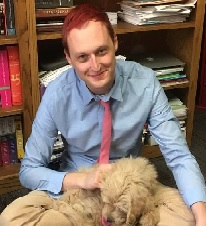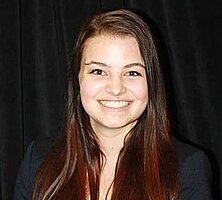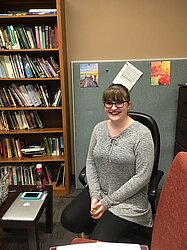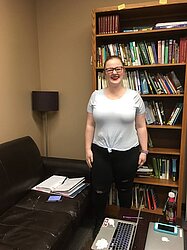Undergraduate Capstone Projects

In their senior year in the English program, our majors participate in ENGL 467, our capstone seminar. Under the guidance of a professor, they embark on an extensive research project, presenting their findings in a public forum at the semester's conclusion. These research endeavors, spanning diverse subjects, allow students to delve deeply into a topic of their choosing over the entire semester.
Our professors actively support and oversee the students throughout their research journey.
Kurt Eggers, BA in English 2017

In fall 2016, Kurt completed his capstone project, "Fargo's Cosplay Community: A Quasi-Ethnographic Study," under the mentorship of Dr. Elizabeth Birmingham. It consisted of an ethnographic study of cosplayers in North Dakota and included a short documentary on Lenny Grindler, a hobbyist who builds electric, life-size models of Dr. Who Dalek on his farm in Valley City, North Dakota.
Kurt is now an MA student in the Department of English at NDSU, where he teaches first-year composition classes. His degree work pursues a similar line of inquiry. Titled "Technocracy and How Star Trek Created the Nerd Billionaire,"his master's thesis focuses on a largely post-marxist analysis of Star Trek. He argues that while Star Trek consistently and purposefully distances itself from capitalism as an economic system, promoting instead a federation of planets and species, it maintains the social and hierarchical ideology of capitalism to such an extent that it has had a demonstrable impact on real life politics and arguable facilitated the nascence of "nerd billionaires" like Jeff Bezos and Elon Musk.Abstract: This article and video accompaniment present an ethnographic look into the cosplay community of North Dakota. It analyzes scholarly work regarding cosplay in the context of fan studies and brings the discussion to our region through interviews with cosplayers in both sci-fi conventions and charitable work through Star Wars fan organizations. The data gained through the interviews shows common motivations of cosplayers in North Dakota and what they find enjoyable or fulfilling about cosplay. The research has a particular focus on why and how participants choose a particular character to cosplay as, what they find appealing about that character or the property it is from, and how it relates to their own personal identity. The interviews also analyze the specific artistic methods used to craft the costumes in order to exemplify the wide breadth of artistic media that can be applied to cosplay and how that feature contributes to the community’s inclusiveness. This data shows various motivations ranging from friendship, family, creative expression, and charity. Consequently, the interviews show how artistic expression can lead to social community.
Samantha Krause-Maza, B.A. in English, Fall 2017

Samantha completed her capstone project, "“Paper Indians” and “Indian Printers”: Presswork at the First Indian Industrial School" in Spring 2018 under the mentorship of Dr. Gordon Fraser. She says that the capstone project at NDSU helped her become familiar with how to conduct archival research. She says tt helped set her on a path working with object studies and book histories. Sam is currently a first year PhD student at the University of Chicago. she hopes to focus on Early American Indigenous Studies with Dr. Edgar Garcia.
Abstract: "In Indigenous studies, the voices we seek to hear from often had little to no opportunities to write, their writings were lost, or their writings were closely monitored and governed. Such is the case with many students attending the Carlisle Indian Industrial School in the late 1800s. Scholars such as Jacqueline Fear-Segal have closely evaluated Carlisle’s newspapers, such as The Indian Helper, and found “Paper Indians” or non-Native American faculty posing as Indian students in published texts. The Indian Helper has a record of Indian student workers, known as the “Indian Printers”, through a photograph for the 1888-1889 school year. The Indian Printers were able to mark their presence at the school in the physical labor (type setting, printing, etc.) for the newspaper, if not in their own writing. Yet none of them continued on in that profession, nearly all of them pursuing a career in farming instead. The press work, their labor, of the Indian Printers can be read in a way similar to a text, giving us evidence of existence from a group of students for whom agency was complicated."
Rachel Heuer, B.S. in English, Fall 2017

Rachel Heuer completed her capstone project, "Crooked Hillary or Praised Politician? Women in Politics Are Still Facing the Double Bind" in Fall 2018 under the mentorship of Dr. Mary McCall. After graduating, she worked as an Immigration Field Representative. She writes that the focus of her capstone project did not stop after she handed it in. Through her work with Sen. Heitkamp, she has found that the gender bias in politics is still alive and well and hopes to one day see a change in that area.
Abstract: "The aim of this project is to show how women are still facing the double bind in politics, meaning they are being treated differently than male politicians. Hillary Clinton faced gender discrimination during not only the 2016 Presidential Election but during the 2008 Primary Election, as well. During the 2008 Primaries she was scrutinized on how she looked and how she presented herself and in the 2016 Election, she was portrayed in the media as being untrustworthy and constantly told to be “locked up”. The double bind is present in these two events because if Clinton was a male and had done the same political moves in the 2016 Election, she would have been praised and ultimately would have been more likely to have won. If she was seen in a sexual light, the way President Obama was portrayed in 2008, instead of being scrutinized by her cleavage, there could have been a different outcome. By conducting research on these two primary events in Hillary Clinton’s political career, the double bind theory is still alive and well in politics today. Women in politics have yet to break the glass ceiling."
Kaitlyn Grube, B.A. in English, Spring 2018

Kaitlyn completed her project, "Bibliotherapy in the Classroom: Using Literature in Conjunction with Bibliotherapy Techniques to Educate Secondary Students on Suicide" in Fall 2018 under the mentorship of Dr. Kelly Sassi. She is currently an MA student in English and NDSU focusing on studying the appropriation of female pain in politics when using the witch hunt rhetoric.
Abstract: This research essay studies the application of bibliotherapy techniques and psychological fact to educate secondary students on suicidal behavior. Applying bibliotherapy techniques to secondary classrooms introduces the information students need to recognize suicidal behavior in themselves and others while also providing the necessary resources to report instances of suicidal behavior. I use the novel My Heart and Other Black Holes by Jasmine Warga as an example of a contemporary young adult novel that is conducive to bibliotherapy techniques. The results of assignments done by students in the classroom allows secondary instructors to address any inconsistencies students perceive from the text. Applying bibliotherapy techniques to secondary classroom literature pedagogy promotes knowledge and awareness of suicidal behavior, potentially reducing the number of adolescents who commit suicide.
Emily Driscoll, B.A. in English, Spring 2018

Emily completed her capstone project, "Racist Discourse and Immigration: Midwestern White Supremacy in the 21st Century" in Fall 2018 under the mentorship of Dr. Lisa Arnold. She currently works as a general assignment and public assignment reporter at the Fargo Forum. In her work, she has had the opportunity to interview U.S. Senators, including Sen. Amy Klobuchar and Sen. Kevin Cramer. Emily writes that her capstone project is what led her to pursue reporting. Her advice to future capstone students is to choose a topic that is profoundly interesting to you.
Abstract: A group known as the Alternative Right, which emerged in 2010, openly expresses, celebrates, and rallies for the preservation and admiration of white people of European descent as well as the physical and cultural exclusion of other races. Today, there are rallies staged by pro-white activists, like Peter Tefft of Fargo, with hopes to start a “new Roman empire” for whites only. This type of racist rhetoric has been preserved from centuries ago, and continues to normalize racial oppression. As refugee populations grow throughout North Dakota and Minnesota, there is also an upsurge in white nationalism, racism, and hate crime that is nearly parallel to the growing number of new Americans. I have created a journalistic expose of personal encounters with white supremacists and related events that occurred in the Midwest in the past five years and will include filmed interviews and video documentation of groups trying to fight back. I suggest that the Midwest is a festering hotbed of racism because of the demographic circumstances, the current political atmosphere, and racist rhetoric this movement promotes.
Sydney Augusta Dale, B.S. in English, Spring 2018
Sydney completed her capstone project, "An Examination of Self-Diagnosis in Online Autism Spectrum Communities" in Fall 2018 under the mentorship of Dr. Daniel Kenzie. She currently works in Fargo at the North Dakota Autism Center as a Registered Behavior Technician. She works with kids with Autism Spectrum Disorder in order to help modify behavior to them communicate functionally. She writes "I never would've imagined this would be my life half a year after graduating, but I firmly believe my capstone, and those who mentored me through it, set me on a path to success."
Abstract: "The purpose of this project was to examine the reception of self-diagnosis within an online Autism Spectrum Disorder community through forums. The forum site WrongPlanet is a large online community where individuals can communicate with others on the spectrum. The forums were looked at to examine the reception of self-diagnosis in online communities. Using Laura Foran Lewis’ work of examining the role self-diagnosis plays in online communities, the project examines the way individuals within the community react to others who have self-diagnosed. The threads, “Self-Diagnosed People Here Don’t Have Aspergers” and “Poll: Is self-diagnosis okay/valid/a good thing?”, were used to analyze the reactions within the community to self-diagnosis. The forums were qualitatively coded to analyze the language used in the forums and representation of disability in the forums. Within the forums community topics from the mistrust of medical professionals, the usefulness of a diagnosis, and the meaning of Autism Spectrum Disorder was questioned and explored. With a majority of support for self-diagnosis, this project explores the identity found in online communities."
Rachel Reko, B.A. in English, Spring 2018

Rachel Completed her capstone project, "Writing Your Grief: A Study on the Benefits of Creative Nonfiction" in Fall 2018 under the mentorship of Jamee Larson. She is currently an MA student in English at NDSU, focusing on an exploration of witches of color in postcolonial cultures where white fear of witches altered native perspectives of their own magic and religion.
Abstract: "Much of the popular conversation about grief places it firmly as a linear process to be “worked through” until you achieve acceptance, even as academic research has rejected this notion. Since everyone processes grief differently, it is necessary to create as many tools as possible for the bereaved to have at their disposal. One such method involves the writing of creative nonfiction on the subject of the specific loss and/or lost loved one(s). This project focuses on the creation of nonfiction pieces in relation to grief following the loss of a loved one and argues that the benefits of such an exercise include helping people manage their grief and forming a new kind of bond with their deceased loved one(s). I interviewed three grieving mothers before and after they wrote a creative nonfiction piece about their child, in addition to writing my own creative nonfiction piece about my experience with loss. I found, through analysis of these pieces and the subsequent interviews, that the writing process did help all four research participants, myself included, in vocalizing and accepting our grief."


